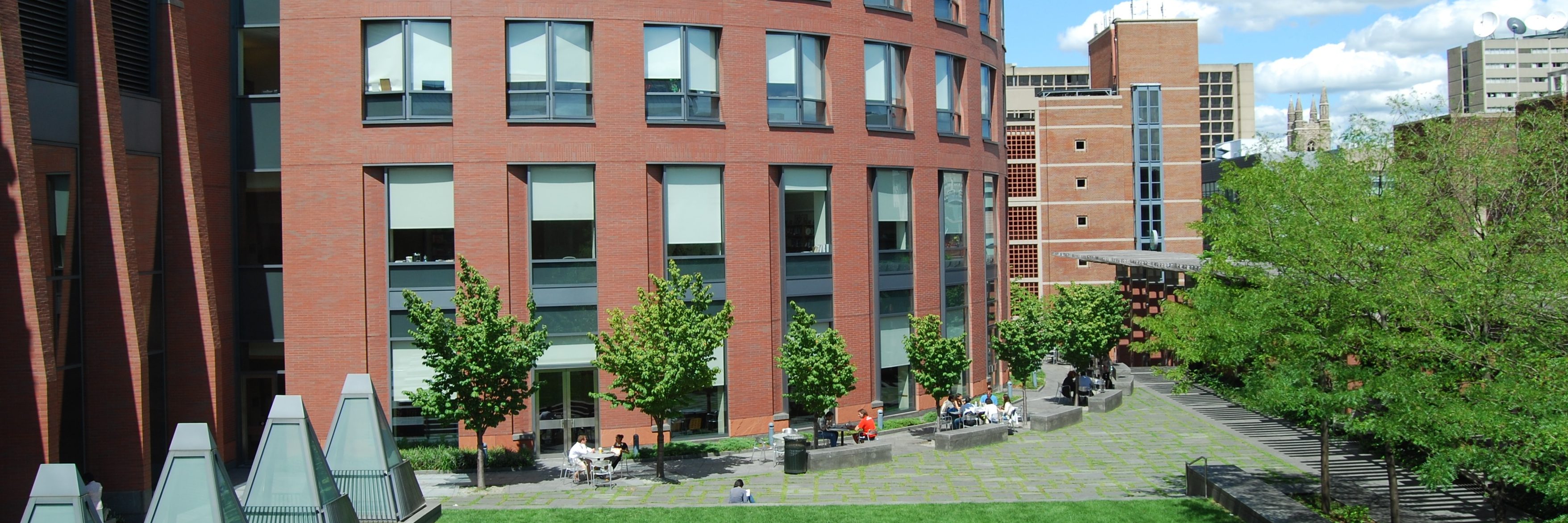The University of Pennsylvania’s Wharton School last week released its Class of 2019 profile, and we connected yesterday with Maryellen Reilly, vice dean of MBA admissions, financial aid, and career services, to discuss some of the highlights. Chief among them: yet another year of enrolling 44 percent women and an uptick in students with a background in science, technology, engineering, and mathematics (STEM).
Overall application volume was largely flat, with 6,692 applications received, up just 13 from last year. Despite her team’s apprehension that international application volume might take a hit or that it could prove difficult for incoming international students to get visas to study in the United States due to the current political climate, neither proved to be the case, Reilly reports.
At 863 students, the incoming Class of 2019 is one of the largest in the school’s history and up 12 from last year. Asked whether this was part of a conscious choice to grow or the result of higher than anticipated yield, Reilly chose not to comment.
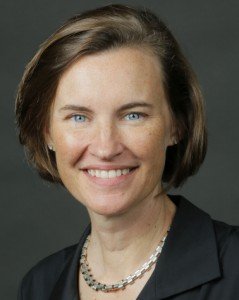
But on how the school has continued to attract the largest percentage of women of all leading business schools—Wharton is ahead of Yale SOM, which drew 43 percent women this year, and HBS and Kellogg, each at 42 percent—Reilly had more to say. “We are building on years of engagement with women,” she said of the school’s strides toward gender parity. “We have a really strong Wharton Women in Business (WWIB) Club and also a male allies club, the Wharton 22s, because we know we are not going to be able to move the dial without everyone—men and women—being involved.”
The Wharton 22s are so named to represent the salary differential between men and women, one it hopes to help change, Reilly notes. Both WWIB and the 22s play a big role in specialty visit days each year geared toward prospective female students, she continues. “We really try to give prospective students a view of what it’s like to be here, and we think that has had a real impact on the volume of applications we receive, not only from women but also from LGBTQ students and students of color,” she says. Students of color and international students both inched up a percentage point this year, from 32 to 33 percent each.
Average GMAT Score Slips a Point, Average GRE Score Reported for First Time
Indeed, assembling a diverse class of talented students is more important than chasing an ever-increasing average GMAT score, Reilly continues. Which could help explain the fact that the school’s average GMAT score has actually slipped a point each of the past two years, from a record 732 for the Class of 2017 to 731 last year and 730 this year. That places Wharton behind Kellogg this year and likely behind Stanford, which hasn’t yet released its Class of 2019 profile but indicated earlier in the summer that it expects this year’s average to near 740.
“We really do look at the whole application,” Reilly explains, noting that even applicants who submit near perfect scores sometimes don’t get in. “People will come to us and say, ‘But I submitted a great score.” To which we reply, ‘You did, but there is so much more to it than that.’”
In fact, Wharton’s GMAT score spread widened this year, ranging from a low of 530 to a high of 790. Last year scores fell between 570 and 780, and the year before, between 620 and 790. “We are super fortunate to see some amazing test scores but also a range of amazing people, so as we are building the class we are looking at more than just scores,” Reilly says. “That’s what you see in our range.”
Wharton also disclosed average GRE scores for the incoming class for the first time this year—163 verbal, 162 quant, and a 4.7 average writing score—part of an effort to demonstrate that the school is truly test agnostic. “Since we began accepting GRE scores, we have seen an increase in people submitting them instead of GMAT scores,” Reilly notes, though she didn’t have specific statistics to cite. “There are lots of people who are taking the GRE because they don’t know if an MBA is exactly what they want,” she notes. “If you can use the GRE to get into a master’s of public health program, for example, we’d love for you to also consider an MBA with a healthcare concentration.” (Seventy-two students in the Class of 2019 are pursuing Wharton’s Health Care Management MBA program, 76 are enrolled in the Lauder MBA/MA joint-degree program in international management, and 14 are JD/MBA students.)
Increased Appetite for STEM Undergrads
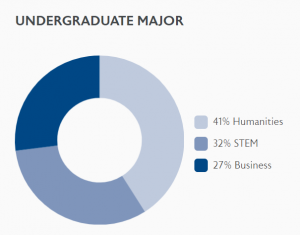 Perhaps the most notable shift in this year’s incoming class was the growth in students who were STEM majors in college. Almost a full third of the Class of 2019—32 percent—have STEM degrees, up from 28 percent last year and just 25 percent the year before. Students with business degrees make up 27 percent, meanwhile, and humanities majors make up the remaining 41 percent, off from last year’s 46 percent.
Perhaps the most notable shift in this year’s incoming class was the growth in students who were STEM majors in college. Almost a full third of the Class of 2019—32 percent—have STEM degrees, up from 28 percent last year and just 25 percent the year before. Students with business degrees make up 27 percent, meanwhile, and humanities majors make up the remaining 41 percent, off from last year’s 46 percent.
The factors contributing to the uptick in STEM majors are many, ranging from increased recruiter demand for MBA grads with more of a science and tech background to the fact that Wharton has expanded its opportunities for students in Silicon Valley, including through the addition of a semester in San Francisco option formally incorporated two years ago.
Reilly also points to another contributing phenomenon. “Over the last five to seven years, more employers who once said to us on the career management side that they don’t hire MBAs have ended up hiring our graduates and realizing that they bring a lot of value,” she says. “By virtue of getting more MBAs into tech firms, we are seeing more of those employers want to hire MBAs,” she continues. Not only that, increasing numbers of younger tech firm employees now view the MBA degree as a means of advancing their career and have begun to apply. “We see real interest from those firms in having us come and visit—both from the admissions and career perspectives.”
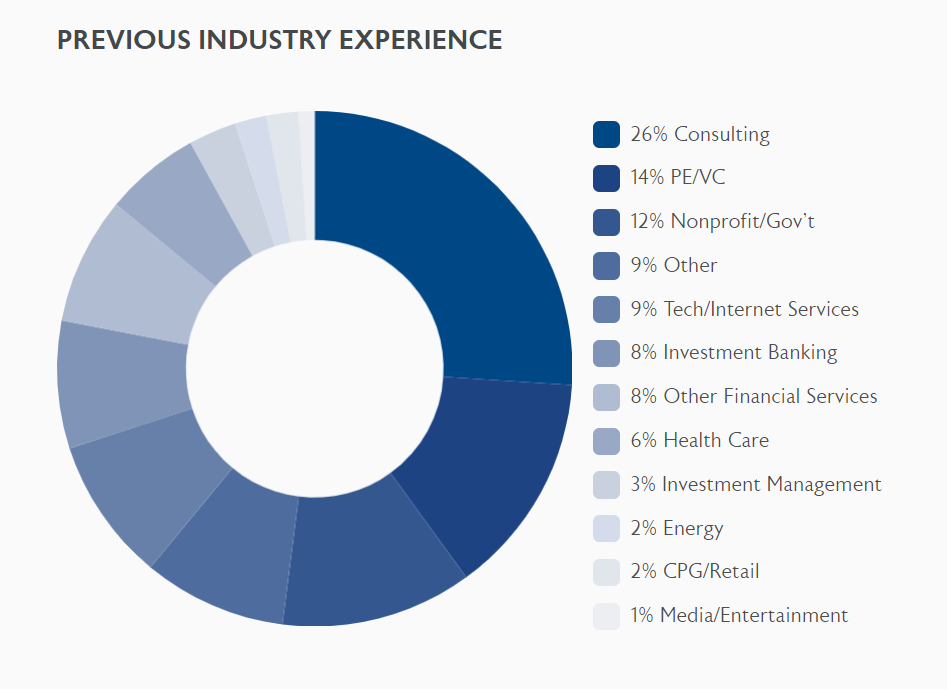
Indeed, incoming students with work experience in the tech and internet industry account for 9 percent of the class—which, while the same as last year, now outpaces the 8 percent from investment banking. All told, finance still sends a full third of the class—counting 14 percent from private equity and venture capital (up from 13 percent), the 8 percent from IB (down from 11 percent), and another 8 percent from “other financial services” (up from 7 percent). Overall, that’s a three-percentage point decline from the year before, when 36 percent of the class boasted finance experience. Students with a consulting background increased over the same time period, from 23 percent to 26 percent. And 12 percent of this year’s class—like last year’s—came in from non-profit or government positions.
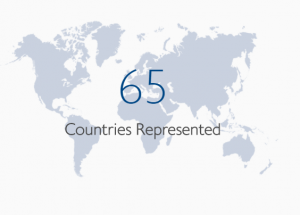 Though she recognizes that there’s always interest when the class profile gets released, to Reilly some of the best parts of Wharton’s newest class can be obscured by the pie charts and numbers on a page. “It’s what happens when they get here that gets me really excited,” she says. “I think it’s hard for people looking at the class profile to truly picture themselves in an environment where there are this many woman in a class or students from so many different countries.”
Though she recognizes that there’s always interest when the class profile gets released, to Reilly some of the best parts of Wharton’s newest class can be obscured by the pie charts and numbers on a page. “It’s what happens when they get here that gets me really excited,” she says. “I think it’s hard for people looking at the class profile to truly picture themselves in an environment where there are this many woman in a class or students from so many different countries.”
Assembling increasingly diverse classes has been a priority at Wharton, she continues, pointing to the fact that the school was one of the first to invite students to self-report LGBTQ status as part of the application, that it waives application fees for veterans, and that it has worked steadily to increase the percentage of women through its work with WWIB and the Wharton 22s.
“By bringing all this diversity on campus and encouraging students—as they move through their time here—to have difficult conversations, we are really trying to help them learn how to be a member of a team that is diverse and to lead and manage in that diversity,” she says. “That’s something that I think gets a little bit lost sometimes because the class profile is really one dimensional.”
Applying to Wharton? Clear Admit’s Wharton School Guide can help you prepare.
